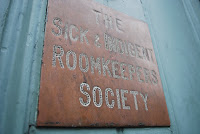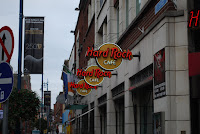"The name Dublin (Baile Átha Cliath) is derived from Dubh Linn, the Dark Pool at the confluence of the Poddle and the Liffey; the Irish name, Baile Átha Cliath, means the city by the hurdle ford."
According to Wikipedia:
Originally founded as a Viking settlement, it evolved into the Kingdom of Dublin and became the island's primary city following the Norman invasion...The city's original pronunciation is preserved in Old Norse as Dyflin, Old English as Difelin, and modern Manx as Divlyn. Historically, in the traditional Gaelic script used for the Irish language, bh was written with a dot over the b, rendering 'Duḃ Linn' or 'Duḃlinn'. Those without a knowledge of Irish omitted the dot and spelled the name as Dublin.We spent our first three nights in Dublin at a B&B called "The Townhouse." This was a spectular and extremely friendly hotel with good food and a great location. It came recommended by an Irish friend here in France and I recommend it now as well.
The first day we took the Dublin siteseeing bus tour which stops at all of the sites with a live commentary. We forgot it was daylight savings time and so were an hour early. That turned out to be good because then we were at the buses just a tiny bit before their first departure.
We rode the bus almost around the entire loop before getting off at Kilmainham Gaol. After that we visited Dubinia and then the Guinness Brewery. Unfortunately all the churches were closed when we started getting off the bus and visiting the sites because it was Sunday.
So we visited Christ Church, Saint Patrick's Cathedral, and Trinity College on Day 2 in Dublin. Then we also visited St. Stephen's Green and Temple Bar to do a little shopping.
On the first night there we went to the movie theaters to see a movie which we hadn't had the opportunity to do since being the US. Unfortunately the movie we saw was completely worthless and a waste of time. It was called, "The Imaginarium of Doctor Parnassus."
Guinness Brewery
Wikipedia says of the property that it was,
Leased for 9,000 years in 1759 by Arthur Guinness at £45 per year, St. James's Gate has been the home of Guinness ever since. It became the largest brewery in Ireland in 1838, and was the largest in the world in 1914, covering 64 acres. Although no longer the largest brewery in the world, it is still the largest brewer of stout in the world.What's missing is a picture of the Gravity Bar which has lots of Guinness and provides the best 360 degree view of all of Dublin.


This is a picture of the outside of Dublinia which is a Viking museum/exhibit.


"Molly Malone" (also known as "Cockles and Mussels" or "In Dublin's Fair City") is a popular song, set in Dublin, Ireland, which has become the unofficial anthem of Dublin City...The song tells the tale of a beautiful fishmonger who plied her trade on the streets of Dublin, but who died young, of a fever.Take a listen...

I can't remember what this was but it was a cool little castle looking thing that I saw on the bus ride.

These are pictures just outside of St. Stephen's Green at the end of Grafton Street. The monument shown is called Fusiliers' Arch and it "commemorates the Royal Dublin Fusiliers who died in the Second Boer War." This is seen in the movie Once at the beginning. This website discusses Dublin and references this movie.
The very handy Michelin Green Guide says this about Grafton Street,
Dublin's finest shopping street is now a bustling pedestrian precinct and a favourite haunt of street musicians.We were fortunate to get to see a really good Irish band called, "Mutefish." We ended up buying their CD and, much to Nicole's chagrin, I listened to it the entire trip.




Saint Stephen's Green
Notice the difference in one letter which is T.K. Maxx instead of T.J. Maxx in Europe (UK and Ireland). We had to do a double take on this one. At the end is a little leprechaun who somewhat resembles my son.
This was a sign we saw in Dublin that looked quite bizarre. We are still not sure what "The Sick Indigent Roomkeepers Society" is but it was founded in 1790. According to this site:
It's the charity with the very odd name, the Sick & Indigent Roomkeepers' Society, but in fact it's the oldest charity in Dublin, still helping the sick and the destitute in the inner city. It was founded in 1790 by a group of eleven concerned citizens, all of whom came from what might be politely called the middle class of society.



Dublin Castle


Miscellaneous Pictures


This next picture is of O'Connell Street and the spire. The second picture is of Rebekkah's leprechaun socks.
The Spire of Dublin, officially called the Monument of Light, "was commissioned as part of a redesigned street layout in 1999...to improve the streetscape." Locals also call it such names as:
- The Spire in the Mire (a reflection on O'Connell Street's unsavoury reputation)
- The Stiletto in the Ghetto (O'Connell St is a very short distance from some of Dublin's poorest and most drug-ruined communities)
- The Nail in the Pale
- The Stiffy by the Liffey (a reference to Dublin's principal waterway, the River Liffey)
- The Pin in the Bin (a reference to the perceived amount of litter in O'Connell Street)
- The Stick
- The Eyeful Tower
- The Rod to God
- The Erection at the Intersection
According to the tour guide Dubliner's on the whole think it was a complete waste of €4,000,000 which they believe could have been much better spent elsewhere to improve things on the street.








No comments:
Post a Comment